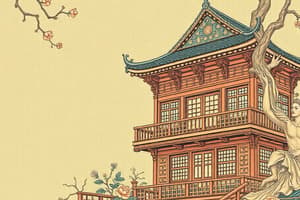Podcast
Questions and Answers
What is the primary function of Katakana in the Japanese language?
What is the primary function of Katakana in the Japanese language?
- To write historical texts
- To represent native Japanese words
- To represent foreign loan words (correct)
- To express grammatical functions
How many basic Katakana letters are there?
How many basic Katakana letters are there?
- 48
- 50
- 46 (correct)
- 49
What are the two modifications of sounds represented by additional symbols in Katakana?
What are the two modifications of sounds represented by additional symbols in Katakana?
- Yōon and gojūon
- Dakuten and tenten
- Sokuon and yōon
- Dakuon and handakuon (correct)
What is the term used for the table that organizes the basic syllables of Katakana?
What is the term used for the table that organizes the basic syllables of Katakana?
Which Katakana letter represents a sound that is skipped in the gojūon-zu table?
Which Katakana letter represents a sound that is skipped in the gojūon-zu table?
What modification indicates the voiced sound in Dakuon syllables?
What modification indicates the voiced sound in Dakuon syllables?
What do the small characters ャ, ュ, and ョ indicate in Yōon?
What do the small characters ャ, ュ, and ョ indicate in Yōon?
Which letter in Katakana represents the same sound as オ?
Which letter in Katakana represents the same sound as オ?
What is the main purpose of Hiragana in the Japanese language?
What is the main purpose of Hiragana in the Japanese language?
Which component of the Japanese phonetic system does Dakuon represent?
Which component of the Japanese phonetic system does Dakuon represent?
What does the term 'gojūon' literally refer to?
What does the term 'gojūon' literally refer to?
Which of the following describes a characteristic of Yōon?
Which of the following describes a characteristic of Yōon?
Which letter is described as having no sound between syllables in the context of Sokuon?
Which letter is described as having no sound between syllables in the context of Sokuon?
How many modified forms of Hiragana are there to describe additional sounds?
How many modified forms of Hiragana are there to describe additional sounds?
What numeral indicates the total number of basic Hiragana letters including variations?
What numeral indicates the total number of basic Hiragana letters including variations?
What does the small circle indicate in the context of Handakuon?
What does the small circle indicate in the context of Handakuon?
Which family is Japanese most widely believed to be connected to?
Which family is Japanese most widely believed to be connected to?
What are the two syllabic scripts used in the Japanese writing system?
What are the two syllabic scripts used in the Japanese writing system?
Which of the following is a characteristic of Japanese vocabulary?
Which of the following is a characteristic of Japanese vocabulary?
During which centuries did the adaptation of Chinese characters significantly influence Japanese?
During which centuries did the adaptation of Chinese characters significantly influence Japanese?
What distinguishes vowel length in the Japanese language?
What distinguishes vowel length in the Japanese language?
Which of the following words is an example of a 'gairaigo' in Japanese?
Which of the following words is an example of a 'gairaigo' in Japanese?
Which consonants can be palatalized in front of the vowels /a/, /u/, and /o/ in Japanese?
Which consonants can be palatalized in front of the vowels /a/, /u/, and /o/ in Japanese?
What is the primary use of the Latin alphabet in modern Japanese?
What is the primary use of the Latin alphabet in modern Japanese?
What happens to the consonants /s/ and /t/ when they occur with the vowel /i/?
What happens to the consonants /s/ and /t/ when they occur with the vowel /i/?
Which script is primarily used for grammatical purposes in Japanese?
Which script is primarily used for grammatical purposes in Japanese?
What is the primary use of Katakana in the Japanese writing system?
What is the primary use of Katakana in the Japanese writing system?
Which of the following statements about Japanese dialects is true?
Which of the following statements about Japanese dialects is true?
What are the three main politeness levels in spoken Japanese?
What are the three main politeness levels in spoken Japanese?
In Japanese, the speaker in a lower position typically uses which form of speech?
In Japanese, the speaker in a lower position typically uses which form of speech?
How many characters approximately form the basic set of Hiragana and Katakana in Japanese?
How many characters approximately form the basic set of Hiragana and Katakana in Japanese?
What is considered the 'common' dialect of Japan?
What is considered the 'common' dialect of Japan?
Flashcards
Japanese Language Family
Japanese Language Family
Japanese is believed to be related to the Ural-Altaic language family, which includes languages like Turkish, Mongolian, Manchu, and Korean.
Kanji Adaptation
Kanji Adaptation
The adoption of Chinese characters (kanji) in Japanese occurred between the 6th and 9th centuries A.D., greatly impacting the language's development.
Hiragana and Katakana
Hiragana and Katakana
These are two syllabic scripts developed from kanji characters to represent sounds and syllables not covered by kanji.
Gairaigo Influence
Gairaigo Influence
Signup and view all the flashcards
Japanese Consonant Palatalization
Japanese Consonant Palatalization
Signup and view all the flashcards
Japanese Writing System
Japanese Writing System
Signup and view all the flashcards
Vocabulary Influence
Vocabulary Influence
Signup and view all the flashcards
Japanese /t/ pronunciation
Japanese /t/ pronunciation
Signup and view all the flashcards
Hiragana & Katakana
Hiragana & Katakana
Signup and view all the flashcards
Open Syllable Structure
Open Syllable Structure
Signup and view all the flashcards
Hiragana Usage
Hiragana Usage
Signup and view all the flashcards
Japanese Vowels
Japanese Vowels
Signup and view all the flashcards
Katakana Usage
Katakana Usage
Signup and view all the flashcards
Japanese Dialects
Japanese Dialects
Signup and view all the flashcards
Standard Japanese
Standard Japanese
Signup and view all the flashcards
Politeness Levels in Japanese
Politeness Levels in Japanese
Signup and view all the flashcards
Katakana
Katakana
Signup and view all the flashcards
Gojūon-zu
Gojūon-zu
Signup and view all the flashcards
Dakuon
Dakuon
Signup and view all the flashcards
Handakuon
Handakuon
Signup and view all the flashcards
Yōon
Yōon
Signup and view all the flashcards
Gojūon
Gojūon
Signup and view all the flashcards
Katakana Syllable Structure
Katakana Syllable Structure
Signup and view all the flashcards
Katakana Usage
Katakana Usage
Signup and view all the flashcards
Hiragana
Hiragana
Signup and view all the flashcards
Gojūon-zu
Gojūon-zu
Signup and view all the flashcards
Dakuon
Dakuon
Signup and view all the flashcards
Handakuon
Handakuon
Signup and view all the flashcards
Yōon
Yōon
Signup and view all the flashcards
Sokuon
Sokuon
Signup and view all the flashcards
Additional Hiragana
Additional Hiragana
Signup and view all the flashcards
Politeness Levels in Japanese
Politeness Levels in Japanese
Signup and view all the flashcards
Study Notes
Introduction to Nihongo
- Nihongo is the Japanese language.
History
- Japanese is believed to be related to the Ural-Altaic family, including Turkish, Mongolian, Manchu, and Korean.
- Japanese shares key features with Korean, such as a similar structure, vowel harmony, lack of conjunctions, and extensive use of honorific speech.
- The adaptation of Chinese characters (kanji) during the 6th-9th centuries AD was crucial to Japanese language development.
- Hiragana and katakana were developed from kanji.
- Starting in the mid-18th century, Japanese adopted a significant number of English words (gairaigo).
- Words also came from Portuguese, Dutch, and Spanish, primarily during the 16th and 17th centuries, through contact from missionaries and merchants.
Characteristics
Vocabulary
- Japanese uses three writing scripts: kanji (Chinese characters), hiragana, and katakana (syllabic scripts).
- Romaji (the Latin alphabet) is also used, commonly for company names, logos, advertising, and computer input.
Morphology
- Japanese vocabulary is significantly influenced by loans from Chinese; words were either borrowed directly or created based on Chinese models over the past 1500 years.
- The late 19th century saw a significant increase in borrowing from Indo-European languages, especially English.
Sound
- Japanese syllable structure is open-syllabled, ending in a vowel.
- Vowel length is significant in distinguishing words (e.g., "door" vs. "too").
- Five vowels are /a/, /i/, /u/, /e/, and /o/.
- Consonants can be palatalized before vowels /a/, /u/, and/o/.
- The syllabic nasal /n/ is a key part of the consonant inventory.
Writing
- The Japanese writing system uses two versions (known as kana) of the same set of sounds, namely hiragana and katakana.
- Hiragana and katakana evolved from simplified versions of Chinese characters (kanji) used for phonetic representation.
- Hiragana is primarily used for grammatical elements, particles, and words with hard-to-find kanji characters for everyday use.
- Katakana is mainly used with loan words imported from other languages (like English).
Varieties
Regional Dialects
- Many dialects exist across Japan, notably in Kyushu and Okinawa, and are often largely incomprehensible to speakers of other dialects.
- Standard Japanese (Tokyo dialect) is the most commonly used dialect and used primarily for communication between speakers of different regional dialectical groups.
- Dialects from Kansai (Kyoto, Osaka, and Kobe) are also widely spoken.
Social Styles of Speech
- Japanese uses an elaborate system of politeness levels for speaking to reflect social and situational hierarchy in communication and relationships.
- Three main politeness levels are often used: the plain form (kudaketa), simple polite (teinei), and advanced polite form (keigo)
- Conversational style in Japanese often adheres to the social rules with the person of "lower status" using a more polite form and the person of "higher status" often using a more formal form of speech.
Hiragana
- Hiragana is a set of 3-character scripts that are used in the Japanese language, including 46 basic hiragana letters (gojūon), along with modified forms.
- The hiragana goon-zu table is organized in 5x10 syllable columns, with the first row representing vowels and columns containing consonants.
- The letters "i", "u", and "e" appear more than once on the table.
- Additional letters include dakuon (voiced sound with two dots), handakuon (half-voiced sound with a circle), and additional letters (yōon, sokuon) for describing sounds of foreign languages often borrowed from other languages.
Katakana
- Katakana is another set of 3-character scripts used in Japanese to represent syllables.
- Katakana (like Hiragana) contains the same set of sounds, but is primarily used for loanwords from other languages.
- Modified forms of katakana include dakuon, handakuon, yōon, and sokuon, for expressing specific sounds.
- The katakana goon-zu table is organized in 5x10 syllable columns, with the first row representing vowels and columns containing consonants. The structure is analogous to the hiragana goon-zu table.
Studying That Suits You
Use AI to generate personalized quizzes and flashcards to suit your learning preferences.




